Rishi Rajpopat: A India Ph.D. Student at Cambridge University Who Solved a 2,500-Year-Old Sanskrit Grammatical Problem
Rishi Rajpopat discovered that the Panini “language machine” mostly generated grammatically correct words with very few exceptions.

Rishi Rajpopat, 27, has decoded a grammatical error that many scholars since the 5th Century BC were not able to solve. Rishi Rajpopat is an Indian Ph.D. student at Cambridge University.
According to the reports, Rishi solved a rule taught by Panini, a master of the ancient Sanskrit language who lived around two-and-a-half-thousand years ago. The Panini’s grammar, known as the Astadhyayi, was based on a system that worked like an algorithm and turned the base and suffix of a word into grammatically correct words and sentences. However, when two or more of Panini’s rules applied simultaneously, they often resulted in rule conflicts.
To Resolve this problem, Panini taught a “metarule“, traditionally interpreted by scholars as meaning “in the event of a conflict between two rules of equal strength, the rule that comes later in the grammar’s serial order wins”.
But Rishi Rajpopat in his Ph.D. thesis, aptly titled In Panini We Trust has rejected this system, opting to go with a simpler interpretation of Panini’s sutras.
"I had a eureka moment at Cambridge!"
The world's greatest grammatical puzzle that had defeated scholars for centuries has been cracked by #Sanskrit PhD student @RishiRajpopat.
Read how he did it 👇@stjohnscam @CambridgeFames @HCI_London
— Cambridge University (@Cambridge_Uni) December 15, 2022

Dr. Rajpopat argues that the meta-rule has always been misunderstood; what Panini really meant, was that for rules applying to the left and right sides of a word, readers should use the right-hand side operation.
Using this logic, Dr. Rajpopat found that the Ashtadhyayi could act as an accurate ‘language machine’, producing grammatically sound Sanskrit words and sentences almost every time.
According to the university, the leading experts in Sanskrit have described Dr. Rajpopat’s discovery as “revolutionary” and it could now mean that Panini’s grammar can also be taught to computers for the first time.
https://youtu.be/1Mx_mW-PK3U
“After nine months of trying to crack this problem, I was almost ready to quit, I was getting nowhere. So, I closed the books for a month and just enjoyed the summer, swimming, cycling, cooking, praying, and meditating. Then, begrudgingly I went back to work, and, within minutes, as I turned the pages, these patterns started emerging, and it all started to make sense. There was a lot more work to do but I’d found the biggest part of the puzzle,” said Dr. Rishi Rajpopat.
“Panini had an extraordinary mind and he built a machine unrivaled in human history. He didn’t expect us to add new ideas to his rules. The more we fiddle with Panini’s grammar, the more it eludes us,” says Rajpopat










